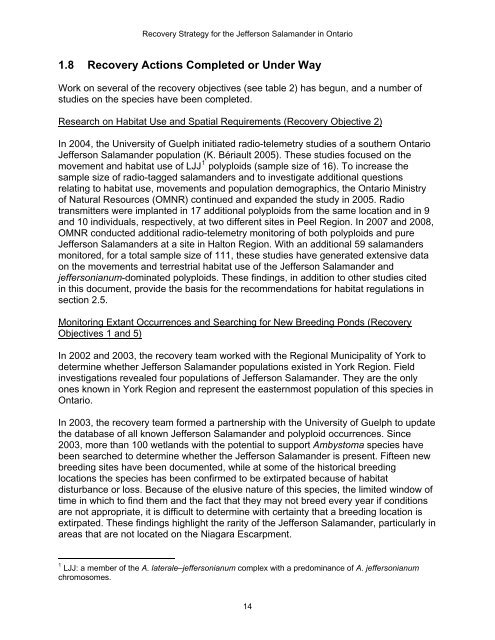Jefferson Salamander - Amphibian Specialist Group
Jefferson Salamander - Amphibian Specialist Group
Jefferson Salamander - Amphibian Specialist Group
You also want an ePaper? Increase the reach of your titles
YUMPU automatically turns print PDFs into web optimized ePapers that Google loves.
Recovery Strategy for the <strong>Jefferson</strong> <strong>Salamander</strong> in Ontario1.8 Recovery Actions Completed or Under WayWork on several of the recovery objectives (see table 2) has begun, and a number ofstudies on the species have been completed.Research on Habitat Use and Spatial Requirements (Recovery Objective 2)In 2004, the University of Guelph initiated radio-telemetry studies of a southern Ontario<strong>Jefferson</strong> <strong>Salamander</strong> population (K. Bériault 2005). These studies focused on themovement and habitat use of LJJ 1 polyploids (sample size of 16). To increase thesample size of radio-tagged salamanders and to investigate additional questionsrelating to habitat use, movements and population demographics, the Ontario Ministryof Natural Resources (OMNR) continued and expanded the study in 2005. Radiotransmitters were implanted in 17 additional polyploids from the same location and in 9and 10 individuals, respectively, at two different sites in Peel Region. In 2007 and 2008,OMNR conducted additional radio-telemetry monitoring of both polyploids and pure<strong>Jefferson</strong> <strong>Salamander</strong>s at a site in Halton Region. With an additional 59 salamandersmonitored, for a total sample size of 111, these studies have generated extensive dataon the movements and terrestrial habitat use of the <strong>Jefferson</strong> <strong>Salamander</strong> andjeffersonianum-dominated polyploids. These findings, in addition to other studies citedin this document, provide the basis for the recommendations for habitat regulations insection 2.5.Monitoring Extant Occurrences and Searching for New Breeding Ponds (RecoveryObjectives 1 and 5)In 2002 and 2003, the recovery team worked with the Regional Municipality of York todetermine whether <strong>Jefferson</strong> <strong>Salamander</strong> populations existed in York Region. Fieldinvestigations revealed four populations of <strong>Jefferson</strong> <strong>Salamander</strong>. They are the onlyones known in York Region and represent the easternmost population of this species inOntario.In 2003, the recovery team formed a partnership with the University of Guelph to updatethe database of all known <strong>Jefferson</strong> <strong>Salamander</strong> and polyploid occurrences. Since2003, more than 100 wetlands with the potential to support Ambystoma species havebeen searched to determine whether the <strong>Jefferson</strong> <strong>Salamander</strong> is present. Fifteen newbreeding sites have been documented, while at some of the historical breedinglocations the species has been confirmed to be extirpated because of habitatdisturbance or loss. Because of the elusive nature of this species, the limited window oftime in which to find them and the fact that they may not breed every year if conditionsare not appropriate, it is difficult to determine with certainty that a breeding location isextirpated. These findings highlight the rarity of the <strong>Jefferson</strong> <strong>Salamander</strong>, particularly inareas that are not located on the Niagara Escarpment.1 LJJ: a member of the A. laterale–jeffersonianum complex with a predominance of A. jeffersonianumchromosomes.14
















